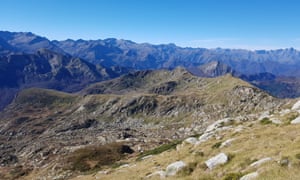Extract from The Guardian
Study finds even supposedly pristine region of the Pyrenees is polluted, but impact on human health remains unknown
Microplastic is raining down on even remote mountaintops, a new study
has revealed, with winds having the capacity to carry the pollution
“anywhere and everywhere”.
The scientists were astounded by the quantities of microplastic falling from the sky in a supposedly pristine place such as the French stretch of the Pyrenees mountains. Researchers are now finding microplastics everywhere they look; in rivers, the deepest oceans and soils around the world.
Other recent studies have found microplastics in farmland soils near Shanghai, China, in the Galápagos Islands, a Unesco world heritage site, and in rivers in the Czech Republic.
Humans and other animals are known to consume the tiny plastic
particles via food and water, but the potential health effects on people
and ecosystems are as yet unknown.The scientists were astounded by the quantities of microplastic falling from the sky in a supposedly pristine place such as the French stretch of the Pyrenees mountains. Researchers are now finding microplastics everywhere they look; in rivers, the deepest oceans and soils around the world.
However the ubiquity of the pollution means it needs to be taken very seriously, said Steve Allen, at the EcoLab research institute near Toulouse and who led the new work in the Pyrenees: “If it is going to be a problem, it is going to be a very big problem. I don’t think there is an organism on Earth that is immune to this.”
About 335m tonnes of plastic is produced each year – while it degrades extremely slowly, it can be broken into smaller and smaller pieces. Microplastic pollution in rivers and oceans is now well known but just two previous studies have looked at its presence in the air, one in Paris, France, and another in Dongguan, China. Both found a steady fall of particles.

They found an average of 365 plastic particles, fibres and films were deposited per square metre every day. “It’s astounding and worrying that so many particles were found,” said Allen.
“It is comparable to what was found in the centre of Paris and Dongguan, and those are megacities where a lot of pollution is expected,” said Deonie Allen, also at EcoLab and part of the team. “Because we were on the top of a remote mountain, and there is no close source, there is the potential for microplastic to be anywhere and everywhere.”
The level of plastic particle rain correlated with the strength of the winds and analysis of the available data showed the microplastics could be carried 100km in the air. However, modelling indicates they could be carried much further. Saharan desert dust is already known to be carried thousands of kilometres by wind.
The most common microplastics found were polystyrene and polyethylene, both widely used in single-use packaging and plastic bags. The samples were collected during winter and it is possible that even more microplastic may fall in summer, when drier weather means particles are more easily lifted from the ground by the wind.
Microplastics have been shown to harm marine life when mistaken for food and were found inside every marine mammal studied in a recent UK survey. They were revealed in 2017 to have contaminated tap water around the world and in October to have been consumed by people in Europe, Japan and Russia.
Many scientists are concerned about the potential health impacts of microplastics, which easily absorb toxic chemicals and can host harmful bacteria, with some even suggesting people are breathing the particles. The new research shows microplastics can remain airborne.
“When you get down to respiratory size particles, we don’t know what those do,” said Deonie Allen. “That is a really big unknown, and we don’t want it to end up something like asbestos.” Plastic fibres have been found in human lung tissue, with those researchers suggesting they are “candidate agents contributing to the risk of lung cancer”.
Professor Stefan Krause, at the University of Birmingham, UK, and not part of the team, said the new Pyrenees research was convincing: “These findings surely highlight the need for more detailed studies.”
“Frankly we are only at the start of understanding [microplastic pollution],” he said. Krause is leading a project called 100 Plastic Rivers which will produce the first systematic, global analysis of microplastics in freshwater ecosystems. He said the particles pose a range of potential dangers, from affecting soils and food production and carrying toxic chemicals and microbes far and wide.

No comments:
Post a Comment